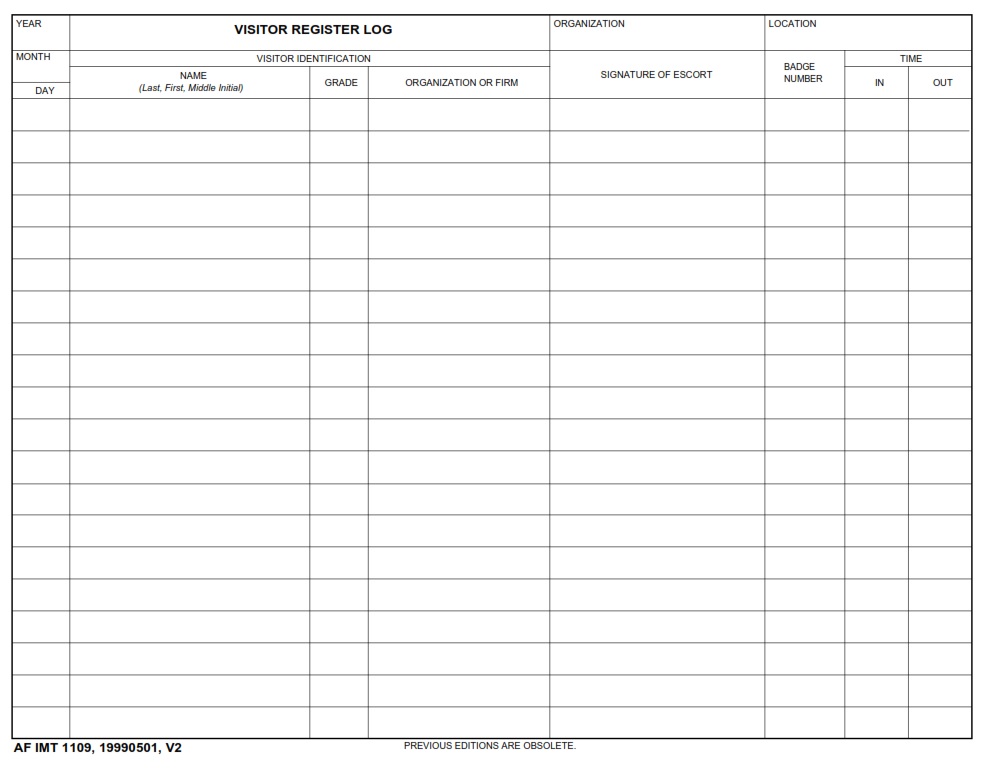AF-FORMS.COM – AF Form 1109 – Visitor Register Log – Are you aware that every visitor who enters a military installation, regardless of the purpose or duration of their visit, must sign in on an AF Form 1109 – Visitor Register Log? This seemingly mundane logbook holds a trove of information about the comings and goings within secure facilities, making it a critical tool for security and accountability. From high-ranking officials to maintenance personnel, each entry in the AF Form 1109 tells a story of access control and risk management that is often overlooked but vital to maintaining the safety and integrity of military installations.
Imagine if this unassuming logbook could speak—what tales it would tell! It holds records of routine visits as well as unexpected arrivals, providing insight into the ebb and flow of visitors within restricted areas. The AF Form 1109 serves as both a historical record and a real-time snapshot, capturing moments when security protocols were put to the test or when unusual events unfolded at the gates. In this article, we will delve into the significance of this unassuming yet indispensable document and explore its role in safeguarding military facilities against potential threats while also facilitating smooth operations for authorized visitors.
Download AF Form 1109 – Visitor Register Log
| Form Number | AF Form 1109 |
| Form Title | Visitor Register Log |
| Edition Date | 5/1/1999 |
| File Size | 43 KB |
AF-Form-1109-Visitor-Register-Log.pdf (51 downloads )
What is an AF Form 1109?
The AF Form 1109, also known as the Visitor Register Log, serves as a crucial tool for documenting visitor information within Air Force facilities. This form captures details such as visitors’ names, arrival and departure times, purpose of visit, and the individual they are visiting. While it may seem like a mundane administrative task, maintaining an accurate record of all individuals entering military installations is essential for security purposes. Additionally, this form can provide valuable data for analyzing visitor trends and identifying potential security risks.
Beyond its security implications, the AF Form 1109 underscores the Air Force’s commitment to accountability and transparency. By diligently recording visitor information, military personnel demonstrate their dedication to upholding rigorous standards of professionalism and orderliness. Moreover, this level of meticulous documentation helps foster a culture of responsibility among members of the Air Force community. Ultimately, the diligent use of the AF Form 1109 not only enhances security protocols but also reflects core values that define the ethos of the United States Air Force.
Where Can I Find an AF Form 1109?
If you’re searching for an AF Form 1109, look no further than the official Air Force e-publishing website. The form, also known as the Visitor Register Log, is readily available in PDF format for easy access. It’s a crucial document used by military bases and other secure facilities to track visitors, ensuring security and accountability.
In addition to the official Air Force website, the AF Form 1109 may also be obtained through unit or facility security offices. These offices often have physical copies of the form on hand and can assist with any specific questions or guidance on its use. Whether it’s for a routine visit or a planned event, having this form readily available ensures smooth entry while adhering to stringent security protocols of military installations.
AF Form 1109 – Visitor Register Log
AF Form 1109, the Visitor Register Log, is a valuable tool for maintaining security and accountability on military installations. This simple yet essential form serves as a record of all visitors entering the premises, providing crucial information such as their name, purpose of visit, and contact details. However, beyond its practical utility, the AF Form 1109 also symbolizes the commitment to safeguarding personnel and resources while upholding transparency in interactions with outsiders. Its meticulous documentation reflects a culture of vigilance and responsibility, where every entry signifies both a potential risk and an opportunity to uphold safety protocols.
Moreover, the Visitor Register Log goes beyond mere bureaucratic requirements; it represents the human element behind security measures. Each name entered into the log signifies not just an individual but a connection between two worlds –the military establishment and the external community. It embodies mutual respect by acknowledging guests while simultaneously reinforcing boundaries that ensure operational integrity. In this sense, AF Form 1109 becomes more than just a form; it becomes a bridge between different spheres of influence – one that supports collaboration while never losing sight of protection.
